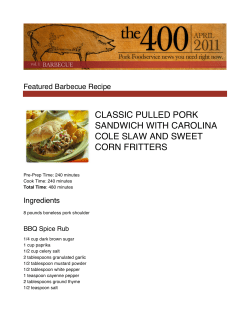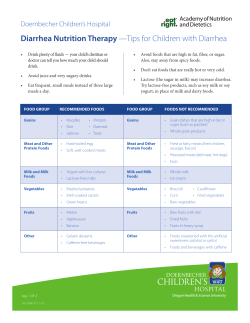
Snacks for Healthy Kids K healthy kids
raising healthy kids Snacks for Healthy Kids Smart Snack Strategies 1 Plan snacks as part of daily food choices • Provide snack choices from several food groups • Schedule regular snack times and amounts; don’t let children nibble constantly during the day (more on page 2) Encourage label 2 detectives • Limit convenience-type snacks that are high in sugar, fat, and salt and use excessive packaging (more on page 2) 3 Create snack stations • Package your own ready-to-go snacks • Allow children to make their own snacks (more on page 3) Provide chef 4 in-training opportunities • Let youngsters help pick out fruits, vegetables, and cheeses when shopping • Include children in snack food preparation • Use snacks to introduce new foods (more on page 4) ➔ Bottom line Healthy snacks supply energy and help meet a child’s daily nutrition requirement Do-it-yourself snacks help children practice independence K ids are experts at snacking According to a United States Department of Agriculture study, after-school snacks provide about one-third of children’s calories. Because children have smaller stomachs, they need the energy and nutrients provided by these minimeals. However, when high fat, high sugar snack foods are combined with screen time—either TV or computer— instead of active play time, children are likely to gain more weight than they should for optimum health. Choosing food implies having POWER Refusing to eat certain foods or demanding to eat others is one way children practice their growing independence. They test values and decide which ones to reject, modify, and adopt. Consequently, doing what everyone else is doing may become more tempting than doing what parents have taught. The key for parents and caregivers is to strike a balance between providing good nutrition and letting children make independent decisions. One way to do this is by offering a wide variety of foods. Provide food choices that offer a range of taste experiences, such as crunchy, soft, chewy, smooth, hot, cold, sweet, sour, bland, and spicy. Food should never be used as a reward for good behavior, or withheld as punishment for bad behavior. Focus on physical activity as well as food All children benefit from physical activity—walking, riding bikes, or playing together is a great way to build family communication. If your child shows a tendency toward being overweight, encourage more physical activity and less screen time at the television or computer. Do not cut back drastically on food intake. Children need those nutrients for growth and development. Distinguish between food facts and myths Current research does not support claims that sugar and food colors are linked to hyperactivity, criminal behavior, or increased anxiety. However, meal-skipping, especially breakfast, has been shown to harm children’s performance in school. PM 1264 Revised February 2012 1 Plan snack choices Offer snacks that fulfill part of the daily recommendation for these food groups. 2–6 years 7–13 years 14–18 years* Grains Veggies Fruits Oil Dairy Protein 5 oz. equivalent 1½ cups 1½ cups 4 tsp. 2 cups 4 oz. equivalent 6 oz. equivalent 2½ cups 1½–2 cups 5–6 tsp. 3 cups 5–5½ oz. equivalent 6–9 oz. equivalent 2½–3½ cups 2 cups 6–8 tsp. 3 cups 5½–6½ oz. equivalent Recommended food intake is based on children who get 30 to 60 minutes of moderate activity, such as walking briskly or biking. *Lower end of range represents the moderately active female while the upper end of the range represents the moderately active male. label 2 Encourage detectives For snacks that do not fit in the MyPlate groups, examine the sugar, fat, and sodium content on the label. Choose more snacks that have: Choose fewer snacks that have: • 2 or more grams of fiber • 10% of the Daily Value for one of the following: • Vitamin A • Vitamin C • Calcium • Iron • 10% or more of the Daily Value for total fat • 10% or more of the Daily Value for sodium • More than 10 to 15 grams of sugar ➔ Remember that every 4 grams equal 1 teaspoon of sugar. 3 Create snack stations Place these snacks in a storage bin or on a shelf in the lower part of the refrigerator so that children can reach them. Also, be sure children have access to water in a cup or bottle. Yummy help-yourself cupboard snacks Place these on a shelf in a cupboard that children can reach. Fruits 100% fruit roll-ups Apple rings, dried Apricots, dried Banana halves Prunes, pitted Raisins Cranberries, dried Pineapple, dried Vegetables Baby carrots* Cauliflowerettes, slightly cooked, chilled Celery sticks* Celery stuffed with peanut butter or cheese* Green or red pepper pieces* Vegetable juices Cherry tomatoes* Zucchini pieces* Ranch Dip (See page 4) Protein Peanut butter Roasted soynuts or pumpkin seeds Sunflower seeds Grains (Choose whole grain options most often; look for whole grain as the first ingredient.) Bagel Banana bread Breadstick Bread, whole grain or enriched Cereal pieces, low sugar (such as Cheerios®, Chex®, Crispix®) Cookies Cornbread Crackers (animal, graham, oyster, whole grain) English muffin Granola, low fat Muffins, low fat Pita bread Popcorn* Pumpkin bread Pretzel, soft Raisin bread Vanilla wafers Whole wheat tortillas Super snacks in seconds Here are some examples of how you and your child could combine foods from the two snack stations for a nutritious snack: ★ Chilly help-yourself refrigerator snacks To help children practice making snack choices, some families set up snack areas in the refrigerator and in a kitchen cupboard. Children are allowed to choose from either. ★ Oatmeal cookies and milk Raw vegetables and cheese dip Cheese and crackers Cottage cheese and fresh fruit Raisin bread toast and fruit juice Fruits Apple wedges* Apple wedges, peeled Applesauce Apricots, fresh or canned Banana chunks Fruit slushes Fruitsicles, frozen Grapes, seedless* 100% juice boxes Kiwi halves Melon pieces Nectarine, fresh Orange sections Tangerine segments Peach or pear pieces, fresh or canned in juice Pineapple chunks Plums, fresh or canned Strawberries Dairy (Choose low-fat milk options most often.) Cheese cubes or slices String cheese Fruit yogurt Milk, plain or flavored Pudding cups Cottage cheese Protein Hard-cooked egg Pears or apples, cheese, and milk Hard-cooked egg and cherry tomatoes Fresh fruit with yogurt dip Kabobs made with fruit and cheese String cheese and fruit juice Celery with peanut butter and fruit juice Sliced apple with peanut butter dip and fruit juice *Caution: These foods may cause choking in children under the age of 5. Money saving tip: Make your own ready-to-go snacks by portioning them into small plastic bags or reusable plastic containers. 4 Provide chef-in training opportunities Healthy snacks taste even better when kids create them with their own hands. Banana Smoothie Make up your own variations using other fruits and juices. 1 small frozen banana, cut in chunks l⁄2 cup plain low-fat yogurt 1⁄4 cup orange juice Put all ingredients in blender and whirl until smooth. These are fairly thick. Add more liquid if you want them thinner. Makes two l⁄2-cup servings. Per serving: 125 calories, 7 grams protein, 213 mg calcium, 10 mg vitamin C, 160 mg sodium. Raisin Banana Mini Muffins** 2 very ripe, medium bananas, peeled 1 egg, beaten 1/3 cup vegetable oil 1 1/2 cups all-purpose flour 1 cup sugar 6 tablespoons unsweetened cocoa powder 1 teaspoon baking soda 1/2 teaspoon salt 1/4 teaspoon baking powder 1/2 cup raisins Spray muffin pan with cooking spray. Preheat oven to 350° F. Put bananas into food processor or blender. Secure lid and blend until smooth. Add egg and oil; cover and blend. In mixing bowl, combine flour, sugar, cocoa, baking soda, salt, and baking powder. Add banana mixture, and stir until moistened. Stir in raisins. Spoon about 1 tablespoon of batter into each muffin pan cup. Bake for 12 to 15 minutes. Cool muffins slightly before removing from pan. Makes 36 mini-muffins. Per muffin: 55 calories, 1 gram protein, 2 grams fat, 9 grams carbohydrate, 43 mg sodium, 3 mg cholesterol * Adapted from: Better Food for Kids, Saab, J. and Kalnins, D. Robert Rose Inc. Toronto, Ontario 2002 ** Reprinted with Permission of Dole Food Company, Inc. Ranch Dip for Veggies* 2/3 cup light sour cream 1/3 cup light mayonnaise 1 tablespoon cider vinegar 1 teaspoon dried dill 1 teaspoon Dijon mustard Pinch of salt Pinch of freshly ground black pepper In a small bowl, whisk together sour cream, mayonnaise, and vinegar until smooth. Add dill, mustard, salt, and pepper. Whisk to blend. Cover and refrigerate up to one week. Makes four 1/4-cup servings. Per serving: 104 calories, 1 gram protein, 9 grams fat, 5 grams carbohydrate, 128 mg sodium, 21 mg cholesterol Mild Salsa Cheese Dip* 1/2 cup mild salsa 1 cup shredded light cheddar cheese 4 ounces light cream cheese 1 to 2 tablespoons ketchup In a small microwaveable bowl, combine salsa, cheddar cheese, and cream cheese. Microwave on medium for 1 minute or until cheeses are melted. Stir in ketchup until mixture is smooth. Cover and refrigerate up to one week, reheating when served. Good with veggies and crackers. Makes four 1/4-cup servings. Per serving: 128 calories, 10 grams protein, 6 grams fat, 6 grams carbohydrate, 615 mg sodium, 19 mg cholesterol Fruity Parfait** Create your own variations by using other fruits as desired. 2 cups chopped fresh pineapple or canned pineapple tidbits 1 cup frozen raspberries, thawed 1 cup low-fat vanilla yogurt 1 firm, medium banana, peeled and sliced 1/3 cup chopped dates 1/4 cup sliced almonds In four glasses, layer pineapple, raspberries, yogurt, banana, and dates. Sprinkle the top with almonds. Makes four servings. Per parfait: 258 calories, 6 grams protein, 5 grams fat, 47 grams carbohydrate, 43 mg sodium, 3 mg cholesterol Check these resources Center for Science in the Public Interest www.cspinet.org/healthysnacks Fruits & Veggies More Matters™ www.fruitsandveggiesmorematters.org/ Fruit & Veggie Color Champions™ (for kids) www.foodchamps.org/ Iowa State University Extension Nutrition www.extension.iastate.edu/ healthnutrition/ Iowa State University Extension Publications https://store.extension.iastate.edu/ Live Healthy Iowa www.livehealthyiowa.org Michigan State University Team Nutrition Booklist and Preschool Booklist http://healthymeals.nal.usda.gov/ hsmrs/MI_Preschool_Booklist.pdf http://www.michigan.gov/documents/ mde/UpdatedMichiganTeamNutritionBooklist_290287_7.pdf MyPlate for Kids www.ChooseMyPlate.gov Revised by Ruth Litchfield, Ph.D., R.D., L.D., extension nutritionist. Originally published as “Simple Snacks for Kids” by Elisabeth Schafer, Ph.D., and Carol Hans, R.D., Ph.D., former extension nutritionists, and Nicholas K. Fradgley, former extension assistant. …and justice for all The U.S. Department of Agriculture (USDA) prohibits discrimination in all its programs and activities on the basis of race, color, national origin, age, disability, and where applicable, sex, marital status, familial status, parental status, religion, sexual orientation, genetic information, political beliefs, reprisal, or because all or part of an individual’s income is derived from any public assistance program. (Not all prohibited bases apply to all programs.) Persons with disabilities who require alternative means for communication of program information (Braille, large print, audiotape, etc.) should contact USDA’s TARGET Center at 202-720-2600 (voice and TDD). To file a complaint of discrimination, write to USDA, Director, Office of Civil Rights, 1400 Independence Avenue SW, Washington, DC 20250-9410, or call 800-795-3272 (voice) or 202-720-6382 (TDD). USDA is an equal opportunity provider and employer. Issued in furtherance of Cooperative Extension work, Acts of May 8 and June 30, 1914, in cooperation with the U.S. Department of Agriculture. Cathann A. Kress, director, Cooperative Extension Service, Iowa State University of Science and Technology, Ames, Iowa.
© Copyright 2025





















